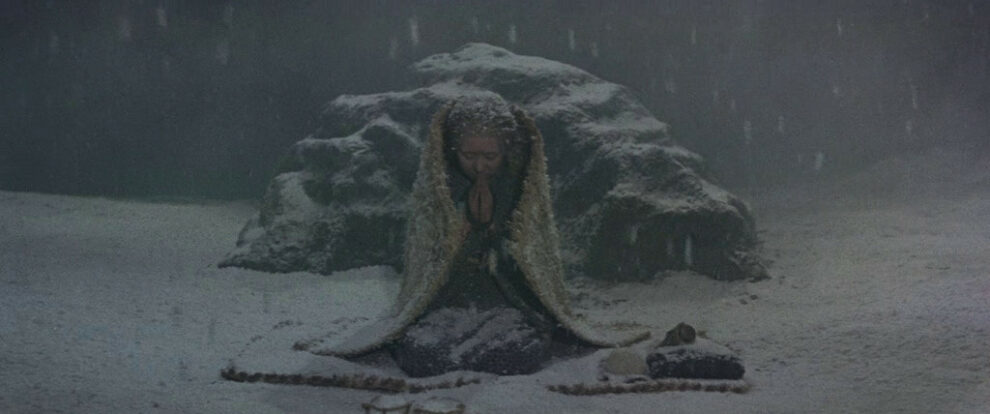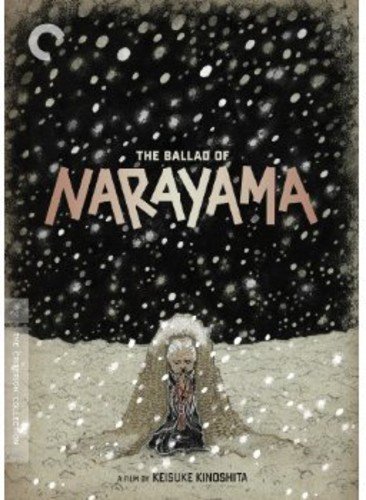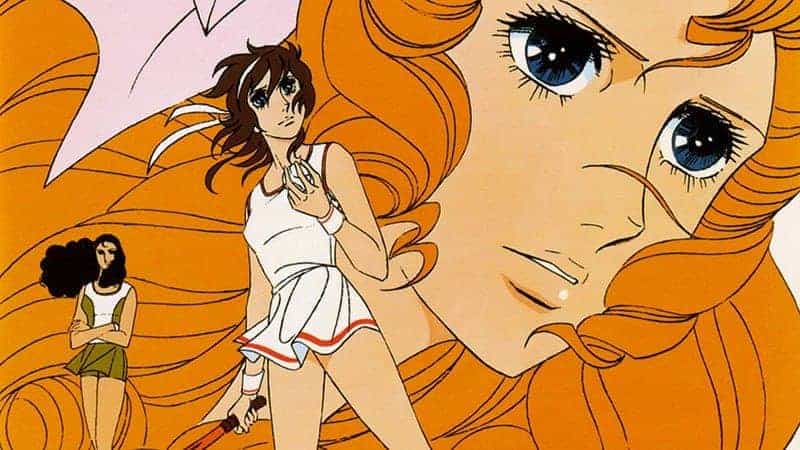Shichiro Fukazawa's story “Narayama” is a haunting tale of ubasute, an ancient practice in Japanese folklore of carrying an elderly family member to a remote area, where they are left to die. Fukazawa's short story has notably been adapted twice. The most popular and successful version is Shohei Imamura's “The Ballad of Narayama,” released in 1983, which was both a critical and financial success and is regarded as a classic. Yet, the first adaptation of the powerful tragedy that came long before is a film that is very different in style from Imamura's depiction but equally wonderful. That magnificent picture is Keisuke Kinoshita's “The Ballad of Narayama.”
By the late 1950s, Keisuke Kinoshita had made quite a name for himself, especially after having graced moviegoers with his powerful film, “Twenty-Four Eyes.” Around the same time, Kinuyo Tanaka had established herself as an acclaimed actress and one of Japan's earliest female filmmakers, notably directing “Forever a Woman.” Kinoshita and Tanaka had worked together before, and it was almost fitting for them to collaborate again on this project while both were maintaining success. “The Ballad of Narayama” would be a critical and financial success in its home country. Yet, it was initially met with divided opinions when featured at the 19th Venice International Film Festival, with some being put off by the feature's theatrical presentation. However, with time, more favorable praise would arise from international viewers, and nowadays, it is considered one of the finest pieces of Japanese filmmaking.
Presented in the style of kabuki theater, a poor mountain village practices a tradition in which people who reach the age of 70 head to a mountain known as Narayama, to which they go and die. The poignant practice, known as ubasute, is performed with the mindset that it would free a younger person of the perceived burden of supporting an aging relative. This ritual is considered sacred for the village, as it is frequently short on food and often met with danger. One of the villagers is an older woman named Orin, who is incredibly healthy, hardworking, and a loving mother. Yet, because of her age, she is approaching the time to which she will be destined to go to Narayama, with the help of her caring son Tatsuhei who will escort her there.
Also check this interview by the author
The movie is a raw tragedy with its presentation of a remote village where food and available resources are scarce. In addition to that is the bleak nature of transferring an aging family member to a mountainside where they are left to die. There is an added level of realism with the lengths villagers will go to in dire times, in harsh living conditions and traditions practiced to sustain order within their developed community. For example, the inhabitants could participate in a festival and then corner a family for stealing food as a last resort.
Adding to the harrowing environment the audience is brought into is the touching family bond between Orin and her son Tatsuhei. For starters, the aging mother is a kind and proactive individual. She doesn't let her age hold her back and is a positive figure in her family household. There is an overwhelming sense of sadness that she is to abide by these strict traditions that will eventually result in her death. Her son also shows clear resistance at points and absolute heartbreak at the idea that he will soon lose his mother. He's still recovering from the death of his former wife, and now he has to come to terms with this impending loss. Even with a new caring wife named Tamayan entering his life, he remains overwhelmed with emotions. The climax in which Tatsuhei carries his mother Orin to Narayama is a powerful sequence.
Quite a cast appears in “The Ballad of Narayama.” Kinuyo Tanaka gives an excellent performance as Orin, the caring elderly mother destined to die at Narayama. Tanaka brings a sweet warmness to the character while simultaneously showing her devotion to the village's traditions. Her gentle personality makes her anticipated fate all the more tragic. The son Tatsuhei is played by Teji Takahashi, who does a great job in the role. He effectively conveys the sadness of knowing he will soon lose his mother, and his bond with her is rather touching. Quite surprising were the lengths the leads went to preparing for their roles. Tanaka had her front teeth removed for a pivotal moment in the film. In addition, Takahashi would lose a ton of weight to add realism to his character's trials.
The supporting players also deliver outstanding work. Keisuke Kinoshita regular Yuko Mochizuki excels as Tatsuhei's caring wife, Tamayan. Opposite to Takahashi's vulnerable character, Danko Ichikawa is comical as the insensitive brother Kesakichi, who is occupied by his pregnant wife Matsuyan, acted by Keiko Ogasawara. A dark contrast to the loving family dynamic of Orin and Tatsuhei is Seiji Miyaguchi playing an older man named Matayan who resists being taken to Narayama by his cold-hearted son, performed by Yunosuke Ito.
The kabuki-style presentation of the picture is wonderfully appealing and technically impressive. The world presented may be conveyed through sets, yet it still feels like a real village. “The Ballad of Narayama” may not have been the first film production to heavily incorporate elements of traditional Japanese theater. However, it further amplifies how those elements can be uniquely utilized in filmmaking. Remember, this came out years before Masaki Kobayashi's anthology picture “Kwaidan,” which similarly incorporated aspects of stage performance in Japan for the art direction. The colors are vibrant, the lighting is exceptionally terrific, and the set pieces and costumes are beautiful, further amplified by Hiroshi Kusuda's excellent cinematography. There is so much attention to detail, right down to some background props. The use of weather also adds to the atmosphere of the movie. A great example is the snow in the finale. Occasionally, Kinoshita effectively uses stage transitions, such as shifting set pieces or a curtain drop leading into the next scene. In addition, the transcendent music score by Chuji Kinoshita and Matsunosuke Nozawa adds to the movie's haunting atmosphere.
Perhaps, the mixed feedback for its international premiere was merely a case of the movie being ahead of its time or cultural unfamiliarity. Nevertheless, “The Ballad of Narayama” is a beautiful film. It is an emotionally raw piece of cinema that is masterfully directed and a visual delight from start to finish. For years, Keisuke Kinoshita's rendition of Shichiro Fukazawa's story had become heavily overshadowed by Shohei Imamura's adaptation. However, it has thankfully regained the attention it deserves. Viewers who enjoyed the Imamura movie should consider giving Kinoshita's version a watch. It is stylistically different, yet just as enthralling.
















